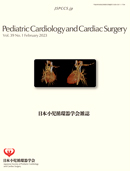Volume 39, Issue 1
Displaying 1-10 of 10 articles from this issue
- |<
- <
- 1
- >
- >|
Preface
-
2023Volume 39Issue 1 Pages 1-2
Published: February 01, 2023
Released on J-STAGE: October 05, 2023
Download PDF (134K)
Review
-
2023Volume 39Issue 1 Pages 3-8
Published: February 01, 2023
Released on J-STAGE: October 05, 2023
Download PDF (256K)
Case Report
-
2023Volume 39Issue 1 Pages 9-15
Published: February 01, 2023
Released on J-STAGE: October 05, 2023
Download PDF (1644K) -
2023Volume 39Issue 1 Pages 18-24
Published: February 01, 2023
Released on J-STAGE: October 05, 2023
Download PDF (7118K) -
2023Volume 39Issue 1 Pages 25-30
Published: February 01, 2023
Released on J-STAGE: October 05, 2023
Download PDF (1481K) -
2023Volume 39Issue 1 Pages 31-36
Published: February 01, 2023
Released on J-STAGE: October 05, 2023
Download PDF (3471K) -
2023Volume 39Issue 1 Pages 39-45
Published: February 01, 2023
Released on J-STAGE: October 05, 2023
Download PDF (1686K)
Editorial Comment
-
2023Volume 39Issue 1 Pages 16-17
Published: February 01, 2023
Released on J-STAGE: October 05, 2023
Download PDF (112K) -
2023Volume 39Issue 1 Pages 37-38
Published: February 01, 2023
Released on J-STAGE: October 05, 2023
Download PDF (107K) -
2023Volume 39Issue 1 Pages 46-48
Published: February 01, 2023
Released on J-STAGE: October 05, 2023
Download PDF (184K)
- |<
- <
- 1
- >
- >|
